You can preserve food naturally using cinnamon bark, just like ancient civilizations did thousands of years ago. The bark's powerful antimicrobial compounds, especially cinnamaldehyde, fight bacteria and fungi that cause food spoilage. You'll get the best results by using Ceylon cinnamon, which skilled artisans harvest using specialized tools like the Sawthtuwa. Simply add ground cinnamon or whole sticks to your foods during drying, curing, or fermentation processes. This spice works particularly well for preserving meats, dairy products, fruits, and baked goods. The fascinating journey of this ancient preservative through time reveals even more powerful applications.
Ancient Origins of Cinnamon Preservation
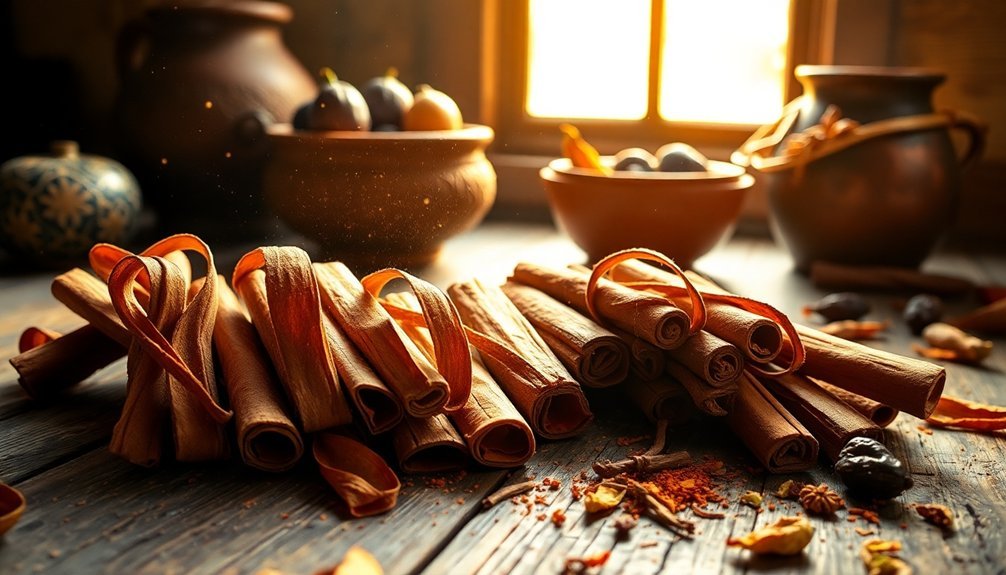
Cinnamon's remarkable journey as a preservative began in ancient Egypt, where skilled embalmers harnessed its powerful properties for mummification. You'll find that ancient Egyptians understood cinnamon's unique characteristics, particularly its antifungal, antiviral, and bactericidal properties, which made it invaluable in their intricate 70-day mummification process.
The preservation methods you're using today have deep roots in these ancient practices. Egyptian embalmers discovered that cinnamon bark oil could help maintain the body in a life-like state, which they believed was essential for the soul's eternal existence. The spice's high polyphenol content made it particularly effective at preventing decay and preserving organic matter.
They'd also incorporate cinnamon into their religious and cultural practices, using it in incense and creating luxurious perfumes by combining it with myrrh.
You can trace cinnamon's widespread adoption to the domestication of camels roughly 5,000 years ago, which established reliable trade routes throughout the Middle East. Despite its high cost, wealthy individuals like Roman Emperor Nero didn't hesitate to acquire this precious spice.
The preservation power of cinnamon comes from its active compounds – cinnamaldehyde, linalool, and eugenol – which you'll find are still relevant in modern food preservation techniques.
Harvesting Sacred Cinnamon Bark
As you look at traditional cinnamon harvesting, you'll find skilled artisans using specialized knives to carefully strip and peel the sacred bark in long, continuous sections.
The practice of sustainable harvesting allows trees to regenerate between collections, with most plantations gathering bark two to three times annually without damaging the tree's health. The ideal conditions for cinnamon growth include warm tropical climates with plenty of rainfall.
Quality assessment focuses on the bark's thickness, color, and curl formation during the drying process, ensuring only the finest cinnamon makes it to market.
Traditional Peeling Methods
Through centuries of tradition, the sacred art of harvesting cinnamon bark follows precise methods that begin in the early morning hours. You'll find skilled harvesters cutting mature stems at 45-degree angles, using curved knives or machetes to begin the process around 5:30 a.m.
They'll remove green parts, side branches, and leaves in the field before bundling the stems for transport. The twice-yearly harvest occurs following the monsoon seasons to ensure optimal bark quality.
In the peeling sheds, you'll need specialized tools to properly remove the outer bark and corky tissues. You'll use a "Kethta" knife to eliminate knots and a "Kokethta" for scraping away rough exterior layers.
To separate the prized inner bark, you'll rub the stems with a brass rod until sap oozes out, signaling it's ready for peeling.
The most vital step requires you to make two parallel incisions around the stem, carefully carving out the soft inner layer in one piece.
You'll then lay these strips in a well-ventilated area, where they'll naturally curl inward while drying. Once golden brown, you'll stack and roll these strips into 42-inch quills, filling them with smaller pieces to guarantee consistent thickness throughout.
Sustainable Harvesting Practices
Standing at the crossroads of tradition and sustainability, responsible cinnamon harvesting embraces two distinct approaches: selective bark removal and complete tree felling. While clearcutting remains common, you'll find selective harvesting offers a more sustainable path, targeting trees with specific diameters in their 10th to 12th year.
You'll want to harvest when new leaves turn green, as the bark peels more easily then. Under good management, you can harvest two to three times annually in regions like Sri Lanka.
To maintain tree health, remove only 1/4 to 1/2 of the bark from one side, allowing natural regeneration for future harvests. When you're cutting, make clean 45-degree angles to promote healthy new growth.
If you're committed to sustainable practices, you'll need to focus on replanting cinnamon seeds and maintaining proper tree density of 1,500 to 1,800 trees per hectare.
Avoid harvesting during flowering or fruiting periods, as this complicates bark removal. Remember, over-harvesting leads to poor-quality cinnamon with higher wood content.
Quality Assessment Guidelines
Every successful cinnamon harvest hinges on rigorous quality evaluation. You'll need to check for living insects, molds, and any foreign matter visible to the naked eye. Your cinnamon should be completely free from coloring additives and harmful contaminants.
When evaluating quality, you're looking for specific traits based on the type. If you're handling Ceylon cinnamon, expect a light, papery bark with lower oil content (about 1%) and minimal coumarin levels (0.02%). For Cassia cinnamon, you'll find thicker, harder bark with higher oil content (2-4%) and higher coumarin levels.
You'll want to verify moisture content, which should fall between 10-14%, depending on the variety. The aroma should be warm, sweet, and woody – never musty or chemical.
When tasting, you're seeking a slightly sweet, warm flavor without any bitter or metallic notes.
For safety compliance, you must confirm your cinnamon's free from lead contamination and heavy metals. It's essential to source from reputable suppliers who follow FDA, GMP, and HACCP standards.
Traditional Bark Processing Methods
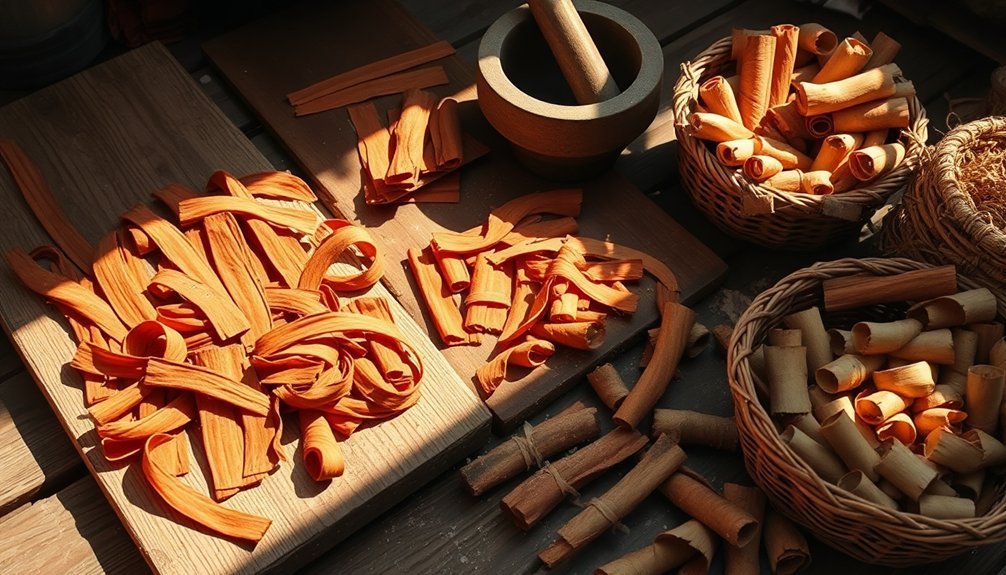
You'll need specific traditional tools like the brass rod and 'Thalana Kokeththa' knife to properly process cinnamon bark into its familiar quill form.
The careful process involves scraping the outer bark, rubbing with brass to release sap, and peeling the inner bark in uniform strips that are then shade-dried for several hours until they coil naturally.
These ancient techniques, passed down through generations, guarantee the bark dries to the perfect 14% moisture content while developing its signature golden-brown color and layered structure.
Drying and Curing Steps
Traditional bark processing involves several precise drying and curing stages to transform raw cinnamon bark into the familiar golden-brown quills.
You'll need to first dry the freshly peeled bark in shade for 2-3 hours during dry weather, or 5-8 hours in wet conditions. If you're using drying racks, they should be made of either coir rope or steel to allow proper air circulation.
Once you've completed the initial shade drying, you'll notice the bark pieces naturally curl inward and develop their characteristic golden-brown color.
If you're working in suitable weather conditions, you can spread the bark in direct sunlight, then bundle it into 20-25kg portions for additional drying. When sun drying isn't possible, you'll need to use drying ovens at 70-75 degrees Celsius for 21 days.
To form the final product, you'll stack and overlap the dried bark pieces to create 106.7-cm quills.
You'll fill any hollow spaces with smaller bark pieces and trim the edges as needed. The quills then require a final 4-7 day indoor drying period on coir rope racks, sometimes covered with gunny bags or cadjan leaves for protection.
Tools for Bark Processing
Successfully processing cinnamon bark requires specific tools designed for precise harvesting and handling. You'll need traditional implements that have proven effective over generations of cinnamon processing, including the sawthtuwa (a pointed knife) for making precise incisions and the pethi kotuwa (wooden lifter) for handling the processed quills.
For ideal bark removal and processing, you'll want to guarantee you have these essential tools:
- A brass rod for rubbing down the inner bark, which helps loosen it from the hardwood and creates a smooth surface
- Coir rope or steel racks for shade drying the peeled bark pieces
- A 107 cm measuring stick to maintain uniform quill lengths during processing
When you're working with these tools, focus on making clean, parallel slits in the bark using the sawthtuwa. The brass rod is vital for proper separation of the bark from the hardwood – you'll need to apply consistent pressure while rubbing to achieve the best results.
As you process the bark, use the pethi kotuwa to carefully handle the quills, making certain they maintain their shape and quality throughout the drying process.
Ancient Preservation Techniques
Throughout history, bark has played a vital role in food preservation, with cinnamon leading the way as one of nature's most effective natural preservatives. You'll find that ancient Egyptians and medieval Europeans relied heavily on cinnamon's powerful compound, cinnamaldehyde, to fight bacteria and fungi in their food storage methods.
When you're studying traditional preservation techniques, you'll notice that different cultures developed unique approaches to using bark. While cinnamon was primarily used to preserve meat and fish, other bark varieties served different purposes.
In Scandinavia, you'd have found people making bark bread from Scots pine and birch bark, especially during times of famine. The Sami people even made pine bark a staple in their diet, consuming it fresh, dried, or roasted.
You can still use these ancient methods today. If you're interested in natural preservation, you'll want to add cinnamon to your food storage arsenal.
It's remarkable how this simple bark has maintained its reputation as a preservative for thousands of years, proving that sometimes the most effective solutions come straight from nature.
Cinnamon's Natural Antimicrobial Powers
Did you know that cinnamon's remarkable antimicrobial properties make it one of nature's most powerful food preservatives? When you're looking to protect your food naturally, cinnamon's broad-spectrum antimicrobial action can help you fight both bacteria and fungi effectively. Its oil and extracts work by disrupting cell membranes and interfering with essential biological processes in harmful microorganisms.
You'll find cinnamon particularly effective against common food-spoiling organisms, with studies showing it can inhibit:
- Dangerous bacteria like *E. coli*, *Salmonella*, and *Staphylococcus*
- Harmful fungi including *Aspergillus* species that cause food spoilage
- Both Gram-positive and Gram-negative bacteria at concentrations as low as 1.25%
You can harness cinnamon's preservative power in multiple ways. Its ethanol extracts offer stronger antimicrobial effects than water extracts, and you'll get the most potent results from cinnamon oil.
Whether you're preserving baked goods, meat, drinks, or dehydrated fruits, cinnamon can help extend shelf life while providing a safer alternative to synthetic preservatives. It's a time-tested solution that's just as relevant today as it was in ancient times.
Essential Compounds For Food Protection
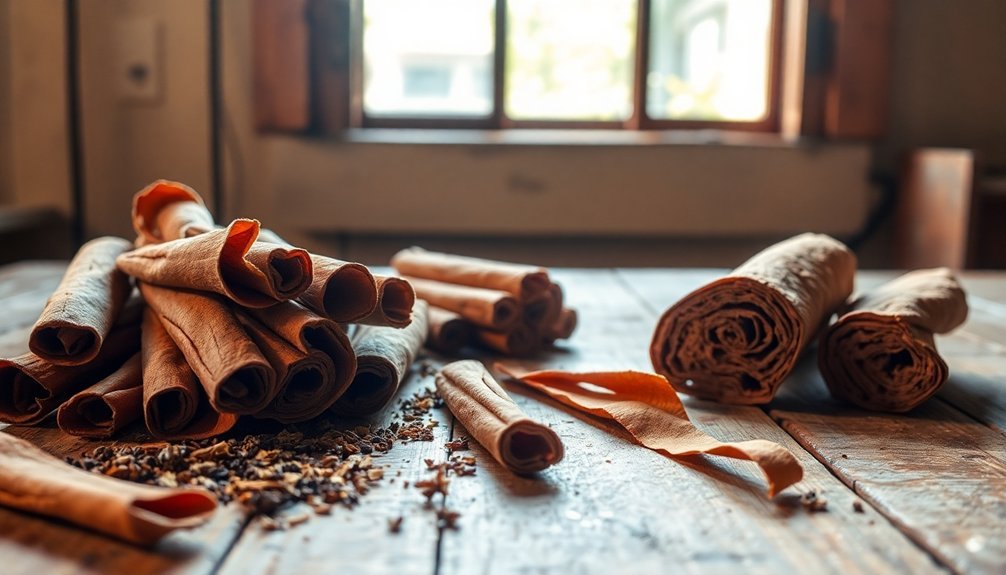
Cinnamon's remarkable preservative powers stem from specific compounds found within its bark. When you're looking to preserve food naturally, understanding these compounds helps you harness their full potential. Cinnamaldehyde, the primary compound, actively fights against bacteria, fungi, and yeasts, while phenolic compounds work as powerful antioxidants to prevent food spoilage.
| Compound | Primary Benefits |
|---|---|
| Cinnamaldehyde | Antimicrobial protection against bacteria and fungi |
| Phenolic Compounds | Antioxidant activity and shelf-life extension |
| Linalool & Eugenol | Synergistic antimicrobial enhancement |
You'll find these compounds can be extracted through various methods, each serving different preservation needs. Solvent extraction works well for obtaining essential oils, while supercritical fluid extraction offers a cleaner alternative. If you're planning to use cinnamon as a preservative, you'll want to take into account hydrodistillation, which is particularly effective for food applications. The combination of these compounds creates a powerful natural preservation system that's been proven through centuries of use. Modern extraction methods are making these compounds even more accessible and effective for food preservation.
Preparing Cinnamon For Food Storage
When you're preparing cinnamon for long-term food storage, start by carefully drying the bark either through traditional sun-drying for 21 days or in a drying oven at 70-75 degrees Celsius.
You'll need to store the dried bark in plastic bags within crates, ensuring the bark remains unbroken to maintain its quality, or process it into ground form using either a spice grinder for Ceylon cinnamon or a rasp grater for Cassia varieties.
For the most effective food preservation properties, you can either use the prepared cinnamon directly or create essential oil, which must be stored in enameled or food-grade plastic containers with a water seal to prevent oxidation.
Traditional Bark Drying Methods
The ancient art of drying cinnamon bark requires precise handling and multiple stages to create the perfect spice for long-term storage. You'll need to follow specific drying methods that have been perfected over generations to maintain the bark's quality and flavor.
When you're processing fresh cinnamon bark, you'll start with shade drying for 2-3 hours (or 5-8 hours during wet seasons) on traditional coir rope or steel racks. After this initial drying, you'll spread the bark in the sun before bundling.
The critical steps for proper drying include:
- Carefully stack shade-dried bark pieces to form cigar-like quills
- Fill these quills with smaller bark pieces and trim for uniformity
- Press the quills by hand and dry them on indoor racks for 4-7 days
For final processing, you'll need to bundle the dried bark into 20-25kg portions and place them in a drying oven at 70-75°C for 21 days.
Don't forget to spread rice bran at the oven's bottom and spray tea on the bundle ends. Once dried, you'll grade the quills based on diameter, thickness, color, and uniformity before creating 45-kilogram bundles for storage.
Safe Storage Techniques
After completing the drying process, proper storage techniques will determine how well your cinnamon maintains its flavor and aroma over time.
You'll want to store your cinnamon in dark-colored glass containers with tight-fitting lids, avoiding plastic which can compromise the spice's quality. Mason jars or specialized spice containers work best, and you can opt for vacuum-sealing for extra protection.
Choose a cool, dry storage location like a pantry or kitchen cupboard, keeping your cinnamon away from direct sunlight and heat sources.
Don't store it in the refrigerator or freezer, as moisture can lead to clumping and mold growth. Instead, a dry basement can serve as an excellent alternative storage space.
You'll need to check your stored cinnamon regularly for any signs of spoilage. Ground cinnamon typically stays fresh for 1-2 years, while whole sticks can last 4-5 years when properly stored.
Remember that ground cinnamon is more vulnerable to degradation due to its increased surface area, so it requires extra care in airtight storage.
When converting between forms, use 1/2 to 1 teaspoon of ground cinnamon for each stick in recipes.
Grinding And Processing Steps
Preparing cinnamon for long-term storage starts well before the grinding process begins. You'll need to verify your cinnamon bark has been properly dried, either through sun exposure or controlled shade drying, depending on weather conditions.
When the bark's fully dried and rolled into quills, you're ready to begin the grinding process.
Start by breaking down your cinnamon quills into smaller, manageable pieces that'll fit in your grinder. You'll want to follow these vital steps:
- Crush the dried quills into smaller fragments using a mortar and pestle or by breaking them by hand.
- Process these pieces through a specialized grinder until you achieve a fine powder consistency.
- Screen the powder through fine mesh to remove any remaining large particles or impurities.
Once you've completed the grinding process, it's important to test your cinnamon powder for quality. Check for proper flavor, aroma, and overall purity before moving forward with storage.
For maximum preservation, transfer your ground cinnamon immediately into airtight containers. This'll help maintain its potency and prevent moisture from compromising its preservative properties.
Best Foods For Cinnamon Preservation
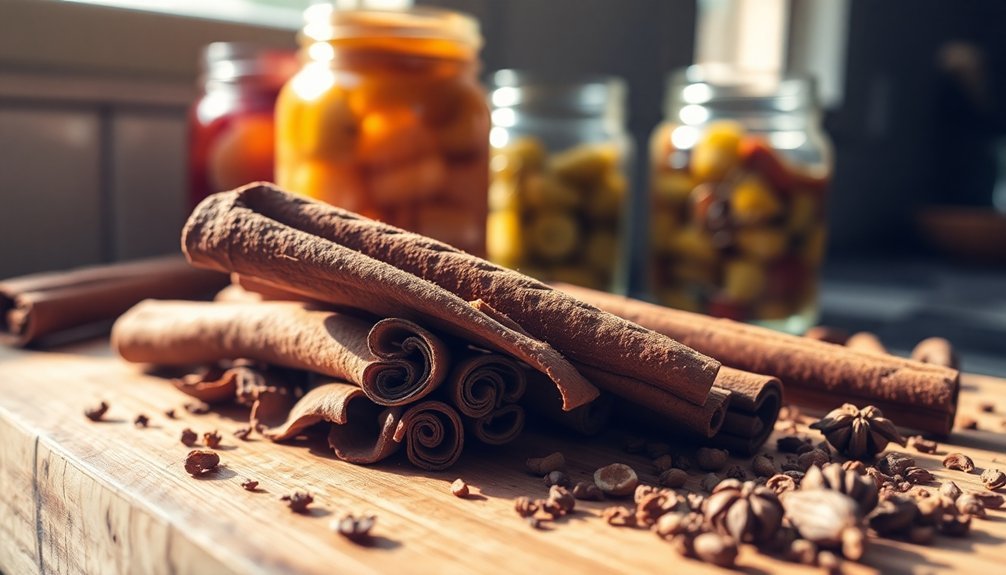
Four major food categories stand out as ideal candidates for cinnamon preservation: meat products, dairy items, fruits and vegetables, and baked goods.
In meat preservation, you'll find cinnamon particularly effective with sausages and chicken. Cinnamomum zeylanicum essential oil (CZEO) works exceptionally well in minced meats, controlling bacterial growth and maintaining color stability during refrigeration. You can apply it directly or use CZEO microcapsules for extended protection.
For dairy products, you'll benefit from cinnamon's natural ability to prevent harmful bacteria in yogurt and cheese. It's especially effective against yeasts and molds that typically cause dairy spoilage, helping extend shelf life while reducing food-borne illness risks.
When preserving fruits and vegetables, you can use cinnamon in dehydration processes or incorporate it into jams and preserves. It's particularly effective in fig and apple preserves, where it both enhances flavor and prevents spoilage.
In baked goods and beverages, you'll find cinnamon invaluable for extending freshness in bread, cakes, and pastries. The oil works as a natural preservative in both baked items and drinks, effectively controlling yeast and mold growth while adding flavor.
Storage Techniques Through Time
Beyond today's spice-based preservation methods, humans have developed ingenious storage techniques spanning thousands of years. From the Middle East to Oriental cultures, people have mastered various ways to keep their food safe and edible for extended periods.
Drying and dehydration, dating back to 12,000 B.C., remain among the most effective techniques you'll find. Whether using the sun's natural heat or specially designed still houses, you're removing moisture that bacteria and mold need to thrive.
When sunlight wasn't sufficient, our ancestors turned to salt-based preservation, using osmosis to draw out moisture and create an inhospitable environment for harmful microorganisms.
Here are three revolutionary preservation milestones that shaped human history:
- The development of root cellars and icehouses for maintaining cool temperatures
- The discovery of fermentation, which not only preserves food but enhances its nutritional value
- The invention of pickling, originally using soured wine or beer
You'll find these ancient techniques still relevant today, as they've proven their effectiveness through millennia of use. From underground storage to salt-curing, these methods continue to influence modern food preservation practices.
Modern Applications of Ancient Methods
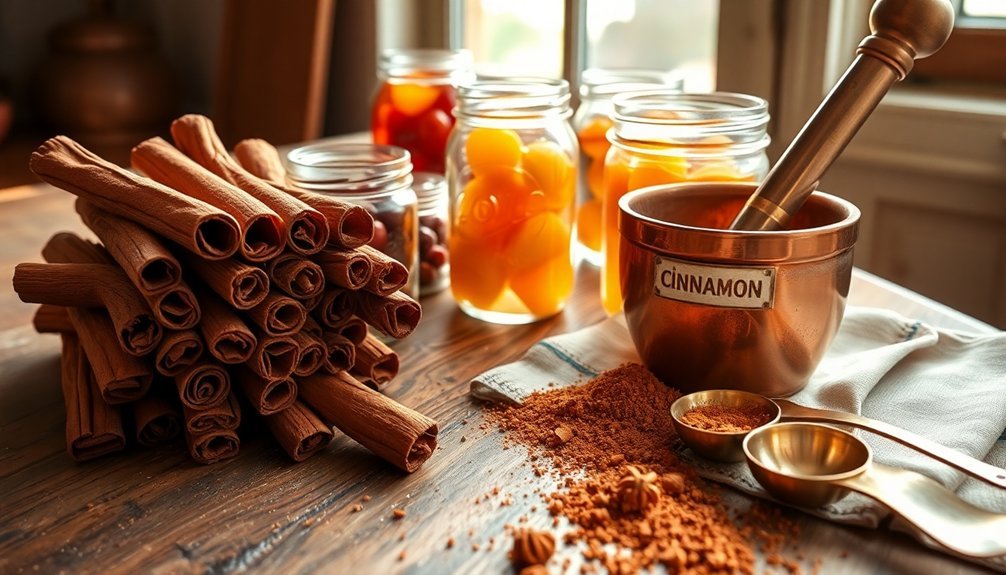
Blending ancient wisdom with modern technology has revolutionized how we preserve food today. You'll find traditional methods like drying, curing, and fermentation now working alongside innovative techniques, particularly when combined with natural preservatives like cinnamon.
You can enhance your food preservation efforts by incorporating cinnamon's powerful antimicrobial properties. Whether you're drying fruits, curing meats, or fermenting vegetables, adding cinnamon helps control bacterial and fungal growth. The active compound cinnamaldehyde works effectively to extend shelf life and maintain food safety.
If you're interested in practical applications, you'll find various ways to use cinnamon in food preservation. You can add cinnamon powder to dried fruits during the dehydration process, incorporate cinnamon oil in meat preservation, or use cinnamon sticks in pickling and fermentation.
Modern extraction methods like hydrodistillation and supercritical fluid extraction have made it easier to harness cinnamon's preservative properties.
You're now able to combine these traditional preservation methods with contemporary techniques, such as using cinnamon-based nanocapsules or incorporating cinnamon extracts into advanced packaging solutions. This integration helps reduce chemical additives while maintaining food safety standards.
Beyond Food Safety Benefits
While cinnamon excels at preserving food naturally, its advantages extend far into the domain of human health and nutrition. You'll benefit from its potent antioxidant properties, which rank impressively high on the ORAC scale. These antioxidants, including polyphenols and flavonoids, actively combat free radical damage and help prevent chronic diseases.
When you incorporate cinnamon into your preservation methods, you're getting these remarkable health advantages:
- Anti-inflammatory support that helps manage blood pressure, reduces triglycerides, and supports digestive health by maintaining gut bacteria balance.
- Powerful antibacterial and antifungal properties from cinnamaldehyde that fight harmful organisms like E. coli, salmonella, and candida.
- Metabolic benefits that help regulate blood sugar levels and reduce insulin resistance.
You're also gaining essential minerals with every sprinkle of cinnamon. It's rich in manganese, calcium, and potassium, while providing beneficial fiber content.
The spice's essential oils, particularly cinnamaldehyde, don't just preserve your food – they're actively working to enhance your overall health through their antimicrobial and anti-inflammatory effects.
Frequently Asked Questions
How Long Does Cinnamon-Preserved Food Last Compared to Chemical Preservatives?
You'll find that chemically preserved foods typically last 20-30% longer than cinnamon-preserved items. However, your cinnamon-preserved foods will still maintain freshness for several months while offering healthier preservation benefits.
Can Cinnamon Bark Be Reused Multiple Times for Preservation?
You can reuse cinnamon bark multiple times, but its preservative power weakens with each use. You'll notice diminished antimicrobial and antioxidant properties, so it's best to limit reuse to 2-3 times maximum.
Does the Age of Cinnamon Trees Affect Their Preservation Properties?
Yes, you'll find that older cinnamon trees (15-20 years) typically produce bark with higher concentrations of preservative compounds like cinnamaldehyde and eugenol, making them more effective for preservation than younger trees.
Are There Any Foods That Shouldn't Be Preserved With Cinnamon?
You shouldn't preserve foods with natural benzoates like yogurt, cheese, and fruit with cinnamon, as this combination can increase preservation compounds to unsafe levels. Also avoid fish products due to cross-contamination risks.
What Temperatures Are Best for Cinnamon-Based Preservation to Work Effectively?
You'll get the best preservation results using cinnamon between 2-8°C, as it maintains the oil's potency. Don't store above 30°C, as higher temperatures will reduce the antimicrobial effectiveness of your cinnamon-based preserves.
In Summary
You'll find that embracing cinnamon bark preservation connects you directly to ancient wisdom while providing modern food safety solutions. Whether you're storing grains, preserving fruits, or protecting meats, this time-tested spice serves as a natural antimicrobial powerhouse. By incorporating these traditional methods into your kitchen, you're not just preserving food – you're keeping alive a sacred practice that's sustained cultures for millennia.

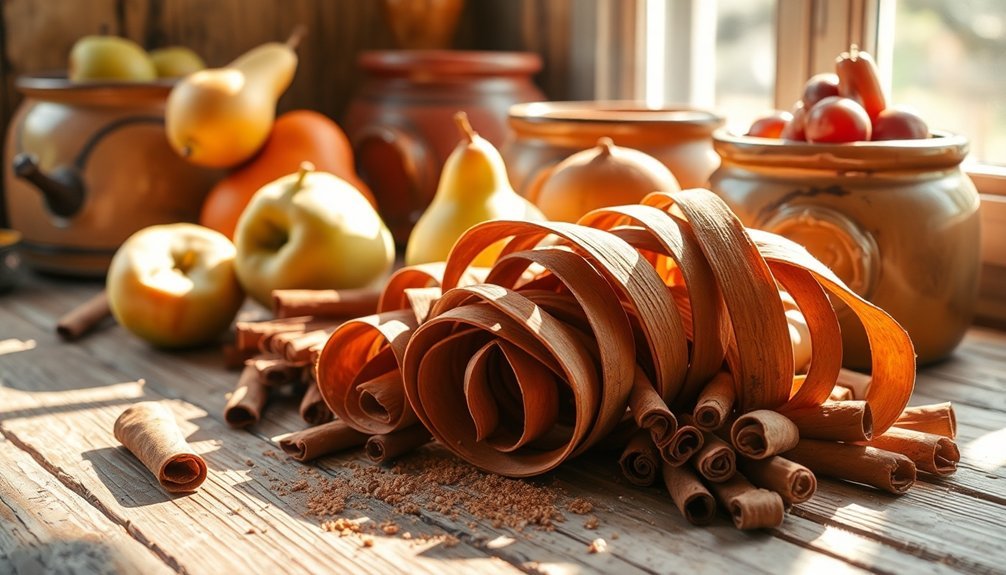



Leave a Reply